Africa is an immense continent. Just how immense didn’t strike home until we saw a graphic depicting how 13 countries that included the lower 48 states, China and India, and the whole of Eastern Europe, fit over Africa’s surface. For good measure, the UK fit nicely over Madagascar. Like we said, immense.
Understand that to bird Africa properly, one would have to take up to as many as ten separate trips. So. Where to begin. Following months of planning, we opted to focus on the country of South Africa. This afforded us the opportunity to see the southern coast (penguins and a pelagic trip), sample two of the largest game preserves (Karoo and Kruger), plus explore a good portion of the Great Escarpment. Loads of geologic wonders. Vineyards. Herds of elephants. Lions, tigers and…hold on. Wrong continent. Just lions. Much of the scenery and wildlife we’ve seen in countless nature documentaries, we now would experience in real time; in real life.
South Africa has a population of around 53 million people speaking eleven “official” languages with “Afrikaans” being the most popular. Developed from the Dutch colonial days, Afrikaans accounted for many tongue-twisting words, phrases and road signs, to those of us unfamiliar with the Dutch language. English, the fourth most commonly spoken language (many commercial businesses used English), is the legacy left by the British Empire.
The country is comprised of nine provinces and is slightly larger in area than Columbia, South America. Its geography ranges from high mountains to sparse scrub to semi-arid grasslands, to rugged coastal plains.
The ZAR (South African Rand) is the principle currency of South Africa. At the time of our trip, the Rand was weak against our U.S. dollar. Roughly speaking, our dollar was 40% stronger so overall, our trip cost less than originally expected.
South Africa's electrical voltage is 230 volts/50 HZ (U.S. is 120 volts/60HZ). This required using massive three-pronged plug adapters and also transformers to safely run electrical devices (phones, iPods, laptops, etc.). In fact, if one were to travel all over Africa, one would need several different kinds of plug adapters (but always the same transformer).
 |
| Trip in three segments |
 |
| first segment rout overview |
 |
| Chris and Dean |
 |
| Harold |
 |
| Risé |
 |
| Pat |
 |
| Tom, Carol |
 |
| Melissa |
 |
| Marge |
 |
| Jose, Lisle |
 |
| Andrew |
 |
| Hadada Ibis on the rooftops |
 |
| paved walkways at Kirstenbosch |
 |
| formal beds |
 |
| King Protea |
 |
| Cape White-eye |
 |
| Cape Sugarbird |
 |
| Double-collared Sunbird |
Our principle Tropical Birding guide for this trip was Andrew Spencer. We had first met Andrew during our two-month volunteer gig at Tandayapa Bird Lodge in Ecuador (2010). In addition to his guiding skills, Andrew is also an accomplished recorder/collector of bird songs/calls (checkout Xeno-Canto for his many contributions). He met us near the main entrance after we’d been exploring the grounds for a few hours, just in time for a spot of lunch at the Tea Room. After filling us in on what to expect over the next several days, he was off to check on more tour arrangements while we continued our garden exploration before returning to the Harfield.
 |
| most of the group at Kirstenbosch entrance |
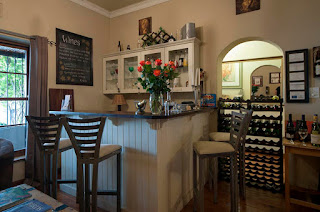 |
| Harfield table setting, part of the breakfast spread, and corner bar/wine selection |
 |
| our Toyota vans allowed us to be more mobile |
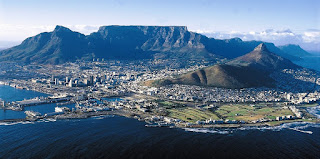 |
| Cape Town with Table Mountain as a backdrop |
 |
| Lisle digitally captured Carol's 2,000th life bird - African Fish-Eagle |
 |
| Cape of Good Hope route |
 |
| Cape of Good Hope coast |
 |
| Bontebok |
There is a misconception that the Cape of Good Hope (Cape Point) is the southern most tip of Africa. While the Cape of Good Hope, is the “most south-western point” of Africa, Cape Aguilhas, some 90 miles further east-southeast, is Africa’s true southernmost tip.
To reach the higher Cape Point promontory there are walking trails, or, one can ride on the Flying Dutchman Funicular. The line runs from the lower Cape Point car park and visitor center, up a steep incline through dense fynbos to the upper lighthouse. It was the first commercial funicular (tram-like vehicles on rails) of its kind in Africa. It takes its name from the legend of the Flying Dutchman ghost ship. The fabled phantom ship legend apparently began here when a Dutch man-of-war was lost with every soul on-board off the Cape of Good Hope in the late 1700’s. Since we were wishing to bird, we forsake the crowded funicular and walked up. From cliff-side vantage points we failed to see any ghost ships but did spy southern wright whales and cape fur seals.
 |
| Malachite Sunbird |
 |
| Boulder Beach, African "Jackass" Penguin |
 |
| Black-winged Stilt |
 |
| Cape Grassbird |
By beating most of the late afternoon rush hour traffic back to the Hartfield we had time to walk to a nearby popular watering hole, the Banana Jam Cafe. Purported to have the best selection of craft beers in South Africa, it did not disappoint. Then we were off to another restaurant (Avenue Grill) for our evening meal.
 |
| jammin' |
Next morning we were up bright and early. An early start to deal with construction congested traffic we would encounter on our way to the Simon’s Town harbor where we would be boarding our boat. Three in the group were not taking the pelagic. Marge, Pat and Harold, accompanied by Andrew, spent the day birding onshore. Originally they would have been accompanied by Lisle but since Lisle was otherwise indisposed, and Pablo isn’t a bird guide, Andrew guided the three landlubbers. Pablo drove us to the harbor and accompanied us on-board. We really didn’t need a Tropical Birding guide since the pelagic company had provided both a boat and guide, a guide intimately familiar with the seabirds we hoped to encounter.
 |
| start of the pelagic |
‘And a good south wind sprung up behind; The Albatross did follow…’ Samuel Taylor Coleridge, The Rime of the Ancient Mariner
Our past experiences with pelagic trips have been, shall we say, less than idyllic. To begin, pelagic trips are expensive. Pelagic trips can be very long (traveling several miles off shore). Pelagic trips don’t guarantee that you’ll see the species you’re hoping to see - merely the chance to see them. Pelagic trips often encounter rough seas (seasickness and salt spray on optics), dense fog (very limited visibility), and honestly, a lot of disappointment when target species aren’t seen. One might have to sign on to do multiple trips over a period of days in order to experience just ONE good trip. We’ve joined pelagic excursions off both coasts of the United States. Our last pelagic was off Cape Hatterass. It had turned into a shoulder and arm numbing 11-hour marathon of hanging on for dear life in a pitched sea, drenched in salt water and with not many birds to show for our effort. Off the California coast we had encountered dense fog for an entire day. With that history, we approached this pelagic with more than just a little trepidation. However, by the end of the trip we were absolutely thrilled beyond our wildest dreams.
Tropical Birding had arranged for Barrie Rose, THE premier guide to be our pelagic guru. Barrie’s background included being involved with Southern Seabird Solutions Trust, part of an alliance with representatives of the seafood industry and government dedicated to seabird conservation and safe (mainly commercial) fishing practices. Barrie had spent years aboard commercial fisheries ships overseeing responsible fishing practices and as a result, has a good working relationship with the area’s commercial fishing ship captains. Barrie had a great sense of humor and was also a very patient person, willing to repeat bird names over and over and over along with each bird’s key field markings. All this interspersed with local history accounts and stories of past pelagic highs (and some lows). UPDATE: Sadly, we have since learned that Barrie, at the age of 60, died in December 2016 during a fishing trip following a fatal fall from a cliff - the same cliff where he had experienced a near death experience with some years back. As all his friends have mentioned, Barrie died what he loved doing - fishing.
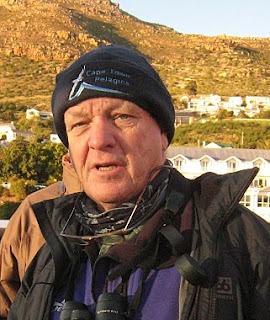 |
| Barrie Rose |
 |
| getting under way and breakfast (Pablo, Carol, Chris, Melissa) |
 |
| rounding Cape Point, heading to sea, and miles later catching up with a fishing boats |
 |
| White-chinned Petrel |
 |
| Indian Yellow-nosed Albatross |
 |
| Cape Gannet |
 |
| Black-browed Albatross |
 |
| White-chinned petrels, Great shearwaters squabble with a Yellow-nosed (Indian) Albatross |
Meanwhile, on shore, our three non-pelagic group members had an exciting day foraging for, and finding, several endemics as well as re-encounters with African Penguins. A lively sharing our various birding experiences that evening as we dined at "Da Vincis on 2nd".
 |
| West Cape route |
We again had opportunities to bird seaboard habitat - coastal wetlands, salt lagoons - plus grasslands, and scenery back-dropped by stately granite “inselbergs”, prominent steep-sided hills of solid rock, rising abruptly and seemingly out of nowhere from the low plains. This was the first day we managed to set our eyes on South Africa’s official bird, the Blue Crane. Anyone who’s visited the International Crane Foundation (Baraboo, Wisconsin) might have seen one there, but here, in the wilds of South Africa, we got to watch them in their natural habitat which seemed to include mixing with domestic livestock. Both the Xhosa and Zulu tribes in Africa revere the Blue Crane. Zulu royalty were the only ones allowed to wear Blue Crane feathers, and Xhosa warriors were only allowed to wear Blue Crane feathers into battle.
 |
| Blue Crane - South Africa's national bird |
 |
| a lot of lining up and looking for LBJ's |
After numerous distant glimpses, we got our first close looks at Chacma Baboons as they interacted within their troops. Roadside warning signs cautioned against leaving your vehicle’s unattended (open doors and/or windows) as baboons have learned that there are treasures to be had inside. Very strong and powerful, once a baboon is in your vehicle, they are very unlikely to leave until they are good and ready and can do a lot of damage “rearranging” your vehicle’s interior.
 |
| baboons and zebra |
 |
| Geelbeck Restaurant and Cape Weaver |
 |
| marsh boardwalk West Coast NP |
Leaving the park we birded our way north to Langebaan Lagoon, cruised the Paternoster Road and stopped at the Veldrif Salt Ponds. African Spoonbills, Plovers (Kittlit’s, Common-ringed, Chestnut-banded), Crowned Lapwing, Common Sandpiper, Ruff, Curlew Sandpiper, Terns (White-winged, Whiskered), Pied Kingfisher, and colorful Bishops (Southern Red, Yellow).
 |
| Andrew had his way of photographing the Puff Adder... |
 |
| ...while I preferred to digiscope from a bit further back |
 |
| and it wasn't limited to just sauce for a braai prepared meat |
The Harfield was full to capacity that night with yet another Tropical Birding tour group. Women from the Chicago area were being guided by Illinois native Josh Engel. As it happened, we would bump into Josh’s group a few more times during our travels.
 |
| Cape Town to Swellendam |
 |
| coastal scene to Sir Lowry's Pass, scanning the scree, Cape Rockjumper |
 |
| African Darter |
 |
| vineyards in the Little Karoo |
 |
| Gray-winged Francolin |
 |
| the guesthouse and our spacious living quarters |
Coming as we do from living in an RV, our room was over the top spacious. A king bed in a room with a vaulted ceiling, an expansive sitting area (we could have entertained our entire tour group), and a bathroom with a hot tub, multiple sinks, and one entire tiled wall with two rain-like producing shower heads. A massive rock rose up out of the bathroom floor. The bathroom alone was as spacious as our kitchen/dining/living room in our RV. Too much!
Just enough time left in the day for happy hour, the daily checklist, a sumptuous home cooked meal before we fell, exhausted, into bed.
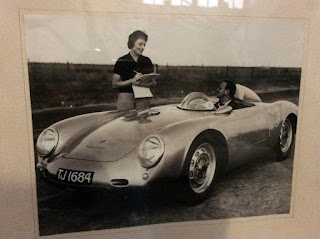 |
| Museum Trophy Room building, photo op of Ian (looks like a Porche 550 Spyder) |
 |
| Swellendam to Wlderness |
 |
| Kingfisher Country House |
 |
| Saying goodbye to Pablo (second from right) |
 |
| Red-chested Flufftail |
 |
| hosts Sue and Phil |
 |
| Fork-tailed Drongo - Tom's 2,000th life bird milestone |
We gathered for breakfast at Kingfisher Guest House where owners Phil and Sue Millard had put out a sumptuous spread.
If we had any fears of not seeing any Turacos on this trip they were quickly laid to rest. Turacos have prominent crests, long tails and are noted for their peculiar and unique pigments giving them their bright iridescent green and red feathers. They are in the family Musophagidae which literally means “banana-eaters”. And they do love their bananas. Sue handily demonstrated this when she had a Knysna Turaco eating out of her hand while she stood along the veranda's railing. It was off this same veranda that a milestone 2,000th life bird for Tom was ticked: a Fork-tailed Drongo. The name makes it sound a lot more fascinating than what it actually looks like but hey, not all milestones can be African Fish-Eagles!
 |
| Knysna Turaco |
 |
| Long-crested Eagle |
 |
| Lisle's digital snap of a Malachite Kingfisher |
 |
| Swartberg Pass overlook |
 |
| Wilderness to Karoo NP |
 |
| Swartberg Pass, Ground Woodpecker |
It was in these rocks that we found our first Ground Woodpeckers. One of only three ground-dwelling woodpeckers in the world, they inhabit barren, steep, and boulder-strewn slopes. Loud and raucous, they will peer over or around rocks at intruders which is exactly the behavior we witnessed.
 |
| Brown-hooded Kingfisher |
After Prince Albert we continued further north toward our next destination, Karoo National Park near the town of Beaufort West. We followed/birded the tarred road leading from the park entrance to the park’s headquarters and the rest camp where we spent the next two nights.
 |
| Karoo NP chalet complete with kitchen |
The landscape is punctuated with “kopje” or “koppies” as they are more commonly known. Kopje are long flat-topped hills (they reminded us of buttes in our American west). Volcanic magma forced upward was the basis of how these were first formed. Over time it has been erosion that has sculpted these iconic flat-topped hills to form protruding “dolerite sills”. After we checked into our Dutch style chalets, we had time to sample some of the wildlife along park roads. Herds of ostrich with males vying for territory. Glimpses of black-backed jackal. Booted Eagle, Pale-Chanting-Goshawk, and Short-toed Rock-Thrush.
 |
| Common Ostrich |
 |
| another fantastic Lisle capture: Black-backed Jackel |
Our guide seemed quite knowledgeable. He kept up a running commentary about the park’s history and inhabitants but sadly, it turned out to be like taking a pelagic: you pays your money and you takes your chances. For us, aside from learning a bit about the park's history, the evening turned out to be a boring bust. The next evening when the rest of the group ventured out, they didn’t fare a whole lot better better. Perhaps the night drives at Kruger National Park would be better.
However, the days spent in and around Karoo more than made up for the lack of night activity. With box breakfasts in hand we explored roads inside and outside the park. While inside the park we were not allowed out of our vehicles except for stopping within specific gated picnic or observation areas. A flip-flop from going to a zoo where we were the ones in the cage while the wildlife roamed free looking at us in our enclosures.
 |
| Vervet Monkey |
 |
| Kori Bustard |
 |
| alas, our best look at Meercats were in a gift shop |
Birding around the rest camp environs netted Red-faced Mousebird, Little Swift, Dideric Cuckoo, Fairy Flycatcher, Yellow-rumped Eremomeia, Canary (Black-headed, White-throated, Protea), Pale-winged Starling, and Black-fronted Bulbul. Of note (at least to us who lived in an RV) were the unusual compact designs of several campers in the park’s campground. Several designs would be of great interest to people we know in the United States wishing to tow a small RV behind a mid-sized SUV.
 |
| Karoo NP back to Cape Town |
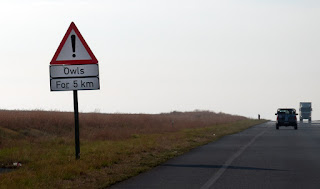 |
| a road sign sure to perk up birders on a long drive |
 |
| Journey's Inn |
NOTE: To view more of Lisle's extraordinary South Africa wildlife photography click HERE and for his photos from Nambia-Botswanna click HERE
 |
| Swee Waxbill |
 |
| African Mourning Dove |
 |
| African Penguin |
 |
| Spotted Eagle-Owl juvenile |
 |
| Cape Bulbul |
 |
| Gray Heron |
 |
| Great Cormorant |
 |
| Greater Double-banded Sunbird male and female |
 |
| Greater Flamingo |
 |
| Hadada Ibis |
 |
| Knysna Turaco |
 |
| Laughing Dove |
 |
| Namaqua Dove |
 |
| Spotted Eagle-Owl adult |
 |
| Pied Kingfisher |
 |
| group on Swartberg Pass |














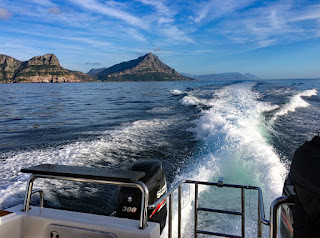



















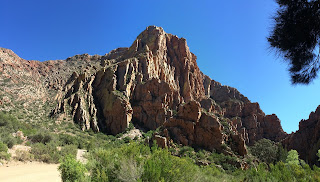









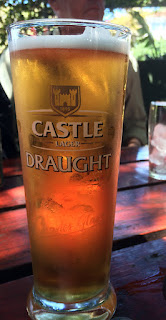




















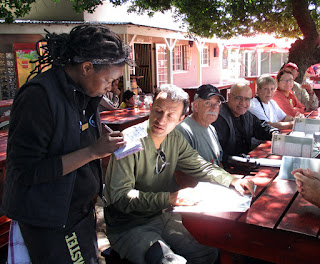



Well done my friends, well done!!! Wow, that African Fish Eagle shot is stunning! So many cool photos - the Blue Crane, Rockjumper, Turac - I can't pick a favorite. Although I'd lean towards that yummy desert Tom is eyeing up ;-D
ReplyDelete